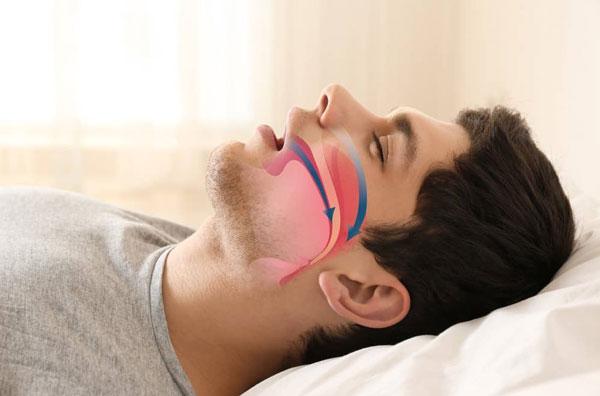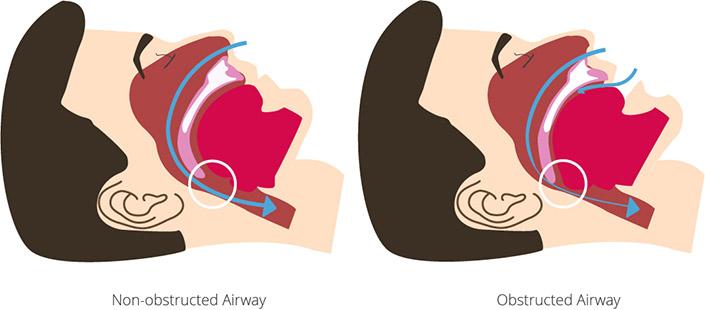
Sleep Apnea
Sleep Apnea Treatment is a sleeping disorder that, if left untreated, may lead to major health concerns such as high blood pressure and heart problems. Untreated sleep apnea causes breathing to stop repeatedly during sleep, resulting in loud snoring and fatigue during the day, even after a full night’s sleep.
Characteristics of Sleep apnea
- Sleep apnea is a serious and possibly fatal illness characterized by repeated cessation of breathing during sleep for up to 10 seconds or more owing to collapse of the upper airway or excessive relaxation of airway muscles.
- This stoppage of breathing may occur hundreds of times every night, leaving you feeling as if you have not slept at all while having a full night’s sleep.
- A decrease in blood oxygen levels- During this time, the body and organs such as the brain and heart do not receive adequate oxygen. This can increase your risk of high blood pressure, heart problems, coronary artery disease, diabetes, and other conditions.
- Frequent awakening in an attempt to breath – The decrease in blood oxygen levels leads your body to wake up, and you may produce a gasping, snorting, or choking sound in an attempt to regain your breath. Because the snorer does not get enough sleep, they may feel drowsy throughout the day.
What are the types of Sleep apnea
Obstructive Sleep Apnea (OSA)
Obstructive sleep apnea is the most common type of sleep apnea, accounting for 84 percent of sleep apnea diagnoses. In most instances of obstructive sleep apnea, a blockage (or obstruction) in the upper airway – that is, in the nose or throat – causes air to stop moving to the lungs.
Central Sleep Apnea (CSA)
Central sleep apnea (CSA) is a less prevalent type of sleep apnea. Even though the airway is open, air does not flow to the lungs since no effort is made to breathe. Because the communication between the brain and the body has been disrupted, the automatic process of breathing stops. Because persons with CSA rarely snore, the condition may go unnoticed.
Mixed Sleep Apnea
This is a mix of obstructive sleep apnea OSA (where the upper airway is blocked or obstructed) and central sleep apnea CSA (where the lower airway is blocked or obstructed).
Causes of Sleep Apnea
- Hypothyroidism
- Hormone-induced growth (acromegaly)
- Allergies
- Septum deviation (problem with nose structure)
- Medical disorders that cause upper airway obstruction
- Using tobacco or alcohol.

Diagnosis of Sleep Apnea:
STOPBANG Questionnaire Method
Adults who experience symptoms of sleep apnea may test themselves using a questionnaire commonly known as the STOPBANG questionnaire.
S- Snoring, T- Tiredness, O- Observed apneas, P- Blood pressure, B- BMI (Body Mass Index-Weight in Kilograms/Height in Meters) >35 kg/m2, Age >50 years
Neck Circumference >16 inches and Gender- Male.
People who score 3 or above on this questionnaire should see a sleep medicine specialist and have a sleep study.
Sleep Study Test A sleep study is a non-invasive, overnight assessment that enables physicians to monitor your brain and body while you sleep to discover what’s going on.
Polysomnogram
A polysomnogram, or overnight sleep study, is part of the testing (PSG). A PSG is carried out in a sleep laboratory under the direct supervision of a pulmonologist. A range of biological activities, including the electrical activity of the brain, eye movements, muscular activity, heart rate, breathing patterns, air flow, and blood oxygen levels, are measured throughout the test at night while sleeping. Following the completion of the research, the number of times breathing is interrupted during sleep is counted, and the severity of sleep apnea is assessed.
Home Sleep Test
Adults may be subjected to a Home Sleep Test (HST) instead. This is a modified sleep study that may be performed in the comfort of your own home. It collects fewer physiological functions than the PSG, such as airflow, breathing effort, blood oxygen levels, and snoring, to confirm a diagnosis of moderate to severe obstructive sleep apnea.
What are the sleep apnea treatments?
Conservative Treatments:
- Weight reduction
- Avoid intake of smoke and alcohol
- Nasal sprays or breathing strips should be used by those who have sinus difficulties or nasal congestion to minimize snoring and increase airflow for more comfortable nocturnal breathing.
Mechanical Therapy:
Positive Airway Pressure Therapy(PAP)
For most persons with obstructive sleep apnea, positive airway pressure (PAP) therapy is the first-line treatment. PAP treatment requires patients to wear a mask over their nose and/or mouth. An air blower is a device that softly propels air via the nose and/or mouth. The air pressure is set just high enough to prevent the upper airway tissues from collapsing during sleep. PAP treatment prevents airway closure while in use, however, apnea episodes reoccur when PAP is discontinued or performed incorrectly. Positive airway pressure devices come in a variety of forms. Styles and types include:
- The most common PAP device is CPAP (Continuous Positive Airway Pressure). The machine is configured to a single section of pressure.
- Bi-Level PAP employs a single pressure during inhalation (breathing in) and a lesser pressure during expiration (breathing out).
- Auto CPAP, also known as Auto Bi-Level PAP, employs a pressure range that self-regulates during usage based on pressure needs recognised by the machine.
- Adaptive Servo-Ventilation (ASV) is a method of non-invasive ventilation used for individuals with central sleep apnea that keeps the airway open and provides a required breath when needed.
Mandibular Advancement Devices
Mandibular advancement devices are used to treat individuals with mild to severe obstructive sleep apnea. It is possible to create dental appliances or oral mandibular advancement devices that assist prevent the tongue from restricting the throat and/or extending the lower jaw forward. These devices aid in keeping the airway open during sleeping.
Hypoglossal Nerve Stimulator
A hypoglossal nerve stimulator is placed under the skin on the right side of the chest, with electrodes tunneled through the skin to the hypoglossal nerve in the neck and intercostal muscles (between two ribs) in the chest. Remote control is used to switch on the device before going to bed. The hypoglossal nerve is activated with each breath, the tongue glides forward out of the airway, and the airway is opened.
Surgery
People with obstructive sleep apnea and others who snore but do not have sleep apnea may benefit from surgical treatments. People who have excessive or deformed tissue impeding airflow through the nose or throat, such as a deviated nasal septum, significantly enlarged tonsils, or a small lower jaw with an overbite that causes the throat to be unusually narrow, may benefit from surgery. These procedures are often done after conservative therapies and a CPAP trial have failed to improve sleep apnea.
Surgical procedures include:
- Somnoplasty is a minimally invasive technique that reduces soft tissue in the upper airway using radiofrequency radiation.
- Tonsillectomy is a surgical treatment that removes tonsillar tissue from the back of the throat, which is a major source of obstruction in children with sleep apnea.
- Uvulopalatopharyngoplasty (UPPP) is a surgical treatment that removes soft tissue from the back of the throat and palate, widening the airway at the throat opening.
- The surgical treatment of certain facial deformities or throat blockages that lead to obstructive sleep apnea is known as mandibular/maxillary advancement surgery. This is an invasive technique designated for individuals suffering from severe obstructive sleep apnea with head-face abnormalities.
- Correction of nasal obstructions, such as a deviated septum, is part of nasal surgery.
Facilities at sleep clinic
Our Sleep Clinic is a forerunner in integrated Sleep care, offering all sleep-related therapies under one roof, as well as top-notch sleep specialists, pulmonologist, and paramedical staff. Our treatment focus includes Multidisciplinary Evaluations, Sleep Studies (polysomnography), and a variety of therapies such as lifestyle adjustments, counseling, CPAP treatments, Mandibular advancement Devices, Surgical Therapy, Diet Counseling, and Psychological Counseling.
- We have a skilled team of sleep medicine specialists
- Our mission is to provide early diagnosis and preventive treatment.
- A holistic approach is used to fulfill all therapeutic requirements.
- A collaborative approach combining all of our professionals, staffs to treat your sleep disorders
- Exclusive sleep lab facilities for advanced sleep investigations.
- The home sleep study is also performed in the comfort of your own home.
- Advanced sleep disorders treatment and counseling are provided here.
For consultation call now: 9029772904 or Book your appointment click here: https://drparthivshah.com/dr-parthiv-shah-appointment/
